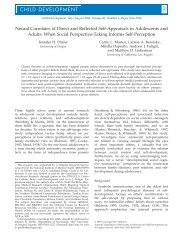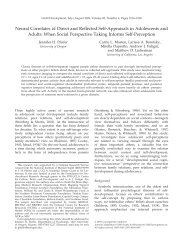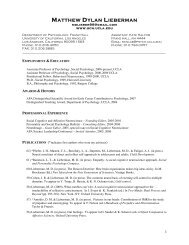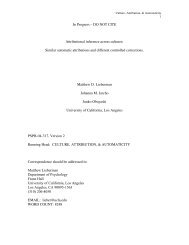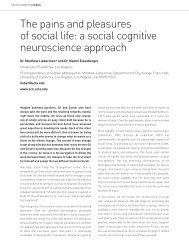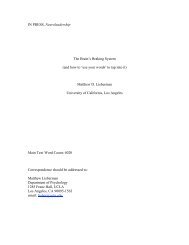Thinking about the Self from a Social Cognitive Neuroscience ...
Thinking about the Self from a Social Cognitive Neuroscience ...
Thinking about the Self from a Social Cognitive Neuroscience ...
- No tags were found...
You also want an ePaper? Increase the reach of your titles
YUMPU automatically turns print PDFs into web optimized ePapers that Google loves.
COMMENTARIES<strong>Thinking</strong> <strong>about</strong> <strong>the</strong> <strong>Self</strong> <strong>from</strong> a <strong>Social</strong> <strong>Cognitive</strong> <strong>Neuroscience</strong> PerspectiveLian Rameson and Mat<strong>the</strong>w D. LiebermanDepartment of Psychology, University of California, Los AngelesIn this paper Kashima et al. develop an interestingmodel of self that attempts to simulate severalpsychological processes critical to an amalgamatedJames-Mead <strong>the</strong>oretical conceptualization ofself. More specifically, <strong>the</strong> authors use a connectionistframework to model temporal, cultural and social aspectsof self which may give rise to <strong>the</strong> enculturatedstream of consciousness which is seen <strong>the</strong> essentialexperience of self in such a model. This approach isimportant as so much of behavioral research has focusedon <strong>the</strong> self as known, in relatively static form, incontrast to <strong>the</strong> dynamic aspects of <strong>the</strong> self that unfold ineach moment and as a function of context. Simple associativeand declarative models of self-representationsare not well equipped to handle <strong>the</strong>se nonlinear dynamics,but connectionist models excel at capturing suchdynamics (Hopfield, 1982).Although <strong>the</strong> authors are primarily interested in usingconnectionism as a tool to model artificial neural architecturethat is capable of supporting self-processes,<strong>the</strong>y also stress that such models should be biologicallyplausible at <strong>the</strong> neural level. An interest in how<strong>the</strong> self is neurally instantiated in <strong>the</strong> living humanbrain has been investigated in recent years by a growingnumber of social neuroscientists, who have usedfunctional imaging techniques to attempt to isolate <strong>the</strong>neural correlates of self-processing. Although <strong>the</strong> effortto understand how <strong>the</strong> self is represented in <strong>the</strong>brain is still in its infancy, such investigations havenone<strong>the</strong>less already proven informative and seem wellworth reviewing here. Due to <strong>the</strong> inherent complexitiesof discussing a phenomena as multifaceted as <strong>the</strong> self,it may be useful to consider this body of research byparsing it into <strong>the</strong> follow categories: self-processingversus o<strong>the</strong>r social processing, internally-focused versusexternally-focused self-processing, and controlledversus automatic aspects of self-processing.<strong>Self</strong> Versus <strong>Social</strong> ProcessingAn unresolved question in social psychology is <strong>the</strong>degree to which <strong>the</strong> self is a unique knowledge structurewhose characteristics differ qualitatively <strong>from</strong>o<strong>the</strong>r kinds of mental representations. This debate waspartly sparked by <strong>the</strong> discoveries that information isbetter remembered when encoded with reference to <strong>the</strong>self (Rogers, Kuiper, & Kirker, 1977) and when it isjudged to be self-descriptive (Derry & Kuiper, 1981).While some researchers have suggested that <strong>the</strong>sefindings constitute evidence for <strong>the</strong> unique nature ofself-representations (Rogers et al., 1977), o<strong>the</strong>rs haveargued that self-reference effects can be explainedby <strong>the</strong> operation of ordinary memory processes suchas elaboration and depth of encoding (Greenwald &Banaji, 1989). In a more recent meta-analysis, it wasfound that <strong>the</strong> memory advantage of self-reference isdiminished but not eliminated when it is compared toconditions in which participants encode informationwith reference to ano<strong>the</strong>r individual, particularly if <strong>the</strong>target is well-known (Symons & Johnson, 1997).The advent of functional imaging has afforded researchersa new tool for investigating whe<strong>the</strong>r <strong>the</strong> selfis represented uniquely in <strong>the</strong> brain. One manner ofaddressing this question is to examine whe<strong>the</strong>r brainregions that are recruited by self-processing are distinct<strong>from</strong> those which are involved in <strong>the</strong> processingof o<strong>the</strong>r similar social information. These studieshave generally employed paradigms in which <strong>the</strong> selfprocessingcondition consists of participants makingself-reflective judgments <strong>about</strong> whe<strong>the</strong>r trait words orsentences are self-descriptive or not. Brain activationin response to this condition is <strong>the</strong>n compared to activationgenerated by comparable judgments of o<strong>the</strong>rindividuals and/or semantic tasks such as judging <strong>the</strong>letter case of a trait adjective.A clear, robust finding that has emerged <strong>from</strong> thisline of research is that cortical midline structuresare consistently engaged when subjects are asked tomake judgments <strong>about</strong> <strong>the</strong>ir own psychological processes,especially when compared to semantic processing(Northoff et al., 2006). In particular, medialprefrontal cortex (MPFC) appears to be heavily recruitedduring self-reflective processing. In one of<strong>the</strong> first fMRI studies to directly examine <strong>the</strong> neuralcorrelates of self-reflection (ra<strong>the</strong>r than <strong>the</strong> monitoringof internal states), Johnson and colleagues (2002)found activation in anterior MPFC (BA 9/10) whencomparing self-reflective judgments (e.g., “I am agood friend”) to semantic knowledge processing (e.g.,“You need water to live”). Recruitment of MPFC forself-judgments compared to semantic judgments hassince been well replicated (D’Argembeau et al., 2005;Fossati et al., 2003; Hea<strong>the</strong>rton et al., 2006; Johnsonet al., 2005; Kelley et al., 2002; Phan et al., 2004;Schmitz, Kawahara-Baccus, & Johnson, 2004; Zysset,Huber, Ferstl, & von Cramon, 2002). The degree ofself-relevance of <strong>the</strong> target stimuli may be an importantmoderator of this effect, as MPFC has been shownto activate more strongly to material judged to be selfdescriptivethan material deemed non-self-descriptive(Macrae, Moran, Hea<strong>the</strong>rton, Banfield, & Kelley, 2004;117
COMMENTARIES118Moran, Macrae, Hea<strong>the</strong>rton, Wyland, & Kelley, 2006).In contrast, stimulus valence does not appear to bea significant moderator of MPFC activation inducedby self-processing, in that MPFC has been shown tobe recruited similarly for self-referentially processingboth negative and positive stimuli (Moran et al.,2006).Fur<strong>the</strong>rmore, MPFC involvement during selfprocessingmay be responsible for <strong>the</strong> previouslydescribed memory advantage observed for selfreferencedstimuli. In a specific investigation of <strong>the</strong>neural correlates of <strong>the</strong> self-reference effect, MPFCactivation in response to judging trait adjectives wasshown to predict subsequent memory for <strong>the</strong> material(Macrae et al., 2004). This finding prompted investigatorsto suggest that MPFC may facilitate <strong>the</strong> encodinginto memory of self-relevant material in much <strong>the</strong> sameway that <strong>the</strong> amygdala is thought to enhance <strong>the</strong> encodingof emotional stimuli. A study by Fossati andcolleagues (2004) dovetails nicely with this finding bydemonstrating selective MPFC activation during retrievalof adjectives that had been previously encodedwith reference to <strong>the</strong> self compared to those which hadbeen encoded semantically or phonemically.Although <strong>the</strong> ubiquitous involvement of MPFCin self-reflective processing seems clear, it is muchless obvious whe<strong>the</strong>r MPFC (or a specific region ofMPFC) is selectively activated for self-judgments. Severalstudies have found essentially no differences betweenneural activity in response to trait self-judgmentsand trait judgments of o<strong>the</strong>rs, including both personallyunknown and close o<strong>the</strong>rs (Craik, 1999; Ochsner et al.,2005; Schmitz et al., 2004; Seger, Stone, & Keenan,2004). However, o<strong>the</strong>r studies which compare <strong>the</strong>sesame conditions evidence greater activation of MPFCduring self-processing compared to o<strong>the</strong>r-processing(D’Argembeau et al., 2005; Hea<strong>the</strong>rton et al., 2006;Kelley et al., 2002; Ochsner et al., 2004). In a recentdevelopmental study, Pfiefer and colleagues (under review)found that in both children and adults MPFC wasmore active when judging <strong>the</strong> descriptiveness of traitsfor <strong>the</strong> self versus a familiar o<strong>the</strong>r.The existing literature suggests several possibleways of understanding how self-processing and o<strong>the</strong>rsocial processing may occur in <strong>the</strong> brain. The first possibilityis that MPFC is generally recruited to <strong>the</strong> sameextent whenever metacognitive evaluation of social informationis required, be it <strong>about</strong> <strong>the</strong> self or ano<strong>the</strong>rindividual. This would suggest that <strong>the</strong>re is little neuraldifference between <strong>the</strong> processes used to psychologicallyevaluate oneself or ano<strong>the</strong>r individual (Bem,1967). A second possibility is that both self-and o<strong>the</strong>rreflectionevoke MPFC activity but to a different extent,which would imply that differences between <strong>the</strong>se twokinds of processing are indexed quantitatively in <strong>the</strong>brain. A third possibility is that <strong>the</strong>re are functionallydiscrete areas of MPFC that make dissociable contributionsto self-and o<strong>the</strong>r-processing in <strong>the</strong> brain. Sucha model implies that <strong>the</strong>re are qualitative differencesin how <strong>the</strong> two processes are neurally instantiated.The latter possibility seems to be most fruitfullyinformed by examining <strong>the</strong> potentially separable contributionsof ventral and dorsal regions of MPFC toself-processing. In general, ventromedial prefrontalcortex (VMPFC) has been linked to emotion and affectiveprocessing while dorsomedial prefrontal cortex(DMPFC) has been associated with cognitive operationsand executive function (Stuss & Levine, 2002).Phillips and colleagues (2003) have proposed a modelthat mapped appraisal <strong>the</strong>ories of emotion perceptiononto distinct ventral and dorsal neural circuitry. Theauthors suggest that a ventral affective system (consistingof ventral prefrontal cortex, amygdala, insula,ventral striatum, and ventral anterior cingulate gyrus)may be important for identifying <strong>the</strong> emotional importof stimuli and producing appropriate affective responses.In contrast, <strong>the</strong> dorsal neurocognitive system(made up of dorsal prefrontal regions, dorsal anteriorcingulate, and hippocampus) is involved in <strong>the</strong>regulation of <strong>the</strong> affective response produced by <strong>the</strong>ventral route. Northoff and Bermpohl (2004) recentlyproposed an analogous model which is specific forself-processing. In this model, VMPFC continuouslyrepresents self-referential material and DMPFC subsequentlyevaluates <strong>the</strong> representations generated byVMPFC. In related work, Schmitz and Johnson (2005)found that self-processing activated both ventral anddorsal MPFC when compared to making decisions<strong>about</strong> target valence. However, when <strong>the</strong> investigatorsconducted connectivity analyses of MPFC activation,<strong>the</strong>y found VMPFC was coupled to amygdala, insulaand nucleus accumbens activity, while DMPFC activitywas coupled to dorsolateral PFC and hippocampus.The authors interpret <strong>the</strong>se findings to mean that <strong>the</strong>ventral route is responsible for generating <strong>the</strong> affectiveexperience of self-related processes, while <strong>the</strong> dorsalroute contributes to <strong>the</strong> cognitive evaluation of <strong>the</strong> stimuliunder consideration. To <strong>the</strong> extent that <strong>the</strong> self isa more intrinsically affect-laden structure than knowledge<strong>about</strong> o<strong>the</strong>rs persons, it may turn out to be <strong>the</strong>case that self-processing could preferentially recruitmore ventral regions of MPFC while o<strong>the</strong>r-processingcould evoke stronger dorsal MPFC activity.In a slightly different approach, Mitchell andcolleagues (2006) have argued that self-processinggenerally recruits VMPFC ra<strong>the</strong>r than DMPFC, butthat mentalizing <strong>about</strong> o<strong>the</strong>rs may differentiallyinvolve ei<strong>the</strong>r VMPFC or DMPFC depending upon<strong>the</strong> situational context. The authors propose that <strong>the</strong>neural networks involved in thinking <strong>about</strong> <strong>the</strong> mindsof o<strong>the</strong>rs will depend upon <strong>the</strong> extent to which using<strong>the</strong> self as a template for understanding o<strong>the</strong>rs issituationally appropriate. That is, <strong>the</strong> self may be auseful model only if <strong>the</strong> o<strong>the</strong>r under consideration is
COMMENTARIESvery similar to oneself. In support of this hypo<strong>the</strong>sis,<strong>the</strong> authors observed a double dissociation in whichmaking judgments <strong>about</strong> <strong>the</strong> self and similar o<strong>the</strong>rscommonly activated VMPFC but making judgments<strong>about</strong> dissimilar o<strong>the</strong>rs selectively activated DMPFC.It is interesting to note that in some ways this <strong>the</strong>oryis <strong>the</strong> converse of that proposed by Kashima et al.:one model suggests that <strong>the</strong> self is created through appropriating<strong>the</strong> experiences of o<strong>the</strong>rs, while <strong>the</strong> o<strong>the</strong>rargues that <strong>the</strong> we use our own experiences as a vehiclefor understanding <strong>the</strong> minds of o<strong>the</strong>rs. O<strong>the</strong>r dataare supportive of <strong>the</strong> target article’s view. In <strong>the</strong> studyby Pfeifer et al. (under review), adults were foundto activate DMPFC more when making social judgments<strong>about</strong> ano<strong>the</strong>r person than when making selfreferentialjudgments (for which VMPFC was moreactive). In contrast, <strong>the</strong> young children in <strong>the</strong> study activatedDMPFC during both social and self-referentialjudgments. These findings may suggest that prior tohave well-established self-knowledge, children mayrely more on social knowledge processes when makingself-judgments than <strong>the</strong>y do later in life.Internal Versus External <strong>Self</strong>-FocusAlthough we have thus far limited our discussionof <strong>the</strong> neural correlates of self-processing to MPFC, itis important to note that posterior midline structuressuch as posterior cingulate, retrosplenial cortex, andprecuneus are also frequently activated in responseto self-processing (Northoff et al., 2006). This coactivationhas prompted some investigators to suggestthat cortical midline structures may be diffusely involvedin self-representation and can even be thoughtof as a single functional unit (Northoff & Bermpohl,2004).Lieberman (2006) recently reviewed evidencewhich suggests that this remarkably robust pattern ofmidline activity may have less to do with <strong>the</strong> targetof mental processes per se (e.g., self versus o<strong>the</strong>r) butra<strong>the</strong>r may depend more critically upon <strong>the</strong> aspect of<strong>the</strong> target being considered. In this review, Liebermanargues that we usually think <strong>about</strong> ourselves ando<strong>the</strong>rs in one of two general ways and that each maybe distinctly represented in <strong>the</strong> brain. The first way istermed internally-focused. In this mode, attention isdirected to intangible aspects of <strong>the</strong> self or o<strong>the</strong>rs, suchas thoughts, feelings or o<strong>the</strong>r contents of <strong>the</strong> mind. Incontrast, externally-focused refers to when <strong>the</strong> targetunder consideration is viewed as a physical objectin <strong>the</strong> world whose characteristics are available to usthrough sensory-mediated channels. It is importantto recognize that it is <strong>the</strong> nature of <strong>the</strong> goal of <strong>the</strong>perceiver that determines processing mode ra<strong>the</strong>r thanan intrinsic property of <strong>the</strong> stimulus. It is likely thatwe adaptively switch processing modes flexibly andwithout conscious awareness in accord with situationaldemands. For example, asking an individualto judge whe<strong>the</strong>r a target is an honest person willprompt internally-focused processing, whereas askingwhe<strong>the</strong>r <strong>the</strong> same target is overweight will initiateexternally-focused processing.Existing neuroimaging data suggests that medialfrontoparietal structures in <strong>the</strong> brain are engaged whenan internal focus is adopted and lateral frontoparietalareas are involved in externally-focused processing.The studies reviewed above support <strong>the</strong> assertion thatmidline structures are important for internal focus as<strong>the</strong>y have generally asked participants to adopt this perspectiveby making trait judgments of <strong>the</strong>mselves. Incontrast, tasks such as self-recognition generate lateralactivations, but not medial activations, in <strong>the</strong> prefrontaland parietal cortices when individuals identify <strong>the</strong>mselvesin pictures (Uddin, Kaplan, Molnar-Szakacs,Zaidel, & Iacoboni, 2005). Similarly, investigationsof agency (<strong>the</strong> sense of being responsible for one’sown bodily movements) generally find that lateral parietalcortex (LPAC) is involved in detecting a mismatchbetween visual and proprioceptive information <strong>about</strong>one’s own body (Farrer et al., 2003; Farrer & Frith,2002; Leube, Knoblich, Erb, & Kircher, 2003; Mac-Donald & Paus, 2003; Shimada, Hiraki, & Oda, 2005).This distinction suggests that in attempting to map<strong>the</strong> neural processes that underlie <strong>the</strong> self, future investigationsshould consider <strong>the</strong> extent to which tasksencourage a specific kind of focus to be adopted. Thisdistinction also reminds us of <strong>the</strong> multifaceted nature ofrepresentations such as <strong>the</strong> self and that fact that <strong>the</strong>reis probably no one specific “self” area of <strong>the</strong> brain.Ra<strong>the</strong>r, many component processes work toge<strong>the</strong>r andunder different circumstances to generate our sense ofself.Dual-Process Models and <strong>the</strong> <strong>Self</strong>One can view much of <strong>the</strong> research on <strong>the</strong> selfthrough <strong>the</strong> lens of dual-process models, which generallyposit <strong>the</strong> existence of two processing modes thatcan be described as controlled and automatic. Controlledprocesses are intentional, operate sequentially,feel effortful, can be interrupted and are availableto awareness (Wegner & Bargh, 1998). Automaticprocesses, on <strong>the</strong> o<strong>the</strong>r hand, lack at least one andpreferably all of <strong>the</strong>se qualities. Neurocognitivesystems have been identified that roughly map onto <strong>the</strong>se two modes of psychological processing(Lieberman, Gaunt, Gilbert, & Trope, 2002).The X-system (named after <strong>the</strong> x in reflexive) isthought to be roughly equivalent to an automatic socialcognition network in <strong>the</strong> brain. It includes VMPFC,amygdala, basal ganglia, lateral temporal cortex (LTC)and dorsal anterior cingulate cortex (dACC). The119
COMMENTARIESX-system processes information in parallel, learnsslowly, does not require cognitive resources, and operatesquickly and without reflective awareness. It isresponsible for <strong>the</strong> creation of our stream of consciousnessand representing our statistical generalizations<strong>about</strong> <strong>the</strong> world.Conversely, <strong>the</strong> C-system (after <strong>the</strong> c in reflective)is thought to roughly correspond to a controlled socialcognition network in <strong>the</strong> brain and includes MPFC,lateral prefrontal cortex (LPFC), lateral parietal cortex(LPAC), medial parietal cortex (MPAC), medial temporallobe (MTL), and rostral anterior cingulate cortex(rACC). In contrast to <strong>the</strong> X-system, <strong>the</strong> C-systemprocesses information serially, learns quickly, operatesslowly and with conscious reflection, and requires cognitiveresources. The C-system appears to be importantfor processing exceptions or symbolic problems thatcannot easily be handled by <strong>the</strong> X-system.In a recent investigation, Lieberman, Jarcho, andSatpute (2004) attempted to parse out how <strong>the</strong>se dualprocesses may operate in <strong>the</strong> brain with respect toself-knowledge. Specifically, <strong>the</strong>y hypo<strong>the</strong>sized <strong>the</strong>existence of two systems, which <strong>the</strong>y termed evidencebasedand intuition-based self-knowledge. Evidencebasedself-knowledge refers to <strong>the</strong> conscious, reflectiveprocesses that are enacted when an individualprocesses information in a low-experience domain.This kind of controlled processing is likely to engageC-system structures, as it will require conscious reflectionand retrieval of episodic memories. In contrast,intuition-based self-knowledge is involved in accessingknowledge in high-experience domains. As such, itis a nonreflective, automatic way of knowing <strong>about</strong> <strong>the</strong>self that should <strong>the</strong>refore operate via X-system neurocognitivestructures.In this fMRI study, individuals who were ei<strong>the</strong>rhighly experienced soccer players or actors judgedwhe<strong>the</strong>r traits related to soccer or acting were selfdescriptive.In line with <strong>the</strong>ir hypo<strong>the</strong>ses, <strong>the</strong> authorsfound that processing information in one’s highexperiencedomain (e.g., actors judging acting words)activated X-system structures. In contrast, processinginformation in one’s low-experience domain (e.g. actorsjudging soccer words) selectively activated componentsof <strong>the</strong> C-system. Thus, it appears that as onegains experience within a domain, <strong>the</strong> neural structuresthat subserve its representation may move <strong>from</strong>brain regions that are associated with conscious controlto those which are more automatic and affective.This change in neural circuitry makes intuitive sensebecause as one gains experience in a particular domain,processing information relevant to that domainis no longer an exception or special symbolic problemrelated to <strong>the</strong> self (province of <strong>the</strong> C-system) but hasbeen incorporated into a generalized schema <strong>about</strong> <strong>the</strong>self (<strong>the</strong> domain of <strong>the</strong> X-system).This research also highlights <strong>the</strong> notion that selfprocessesare diverse and contain both automatic andcontrolled components. In particular, <strong>the</strong>re may be animportant distinction between self-reflection and selfknowledgeactivation. In ano<strong>the</strong>r recent study, Pfiefer,Lieberman, and Dapretto (under review) suggest thatMPFC may be involved in self-reflection but not in accessingstored self-knowledge. The authors observedthat during self-knowledge retrieval adults show lessMPFC activation relative to children. This implies thatMPFC is not a storage site for self-knowledge, asadults have presumably accumulated greater stores ofknowledge <strong>about</strong> <strong>the</strong> self than children. Thus, MPFCmay be important for <strong>the</strong> process of self-reflectionra<strong>the</strong>r than responsible for <strong>the</strong> actual representation ofself-knowledge.In ongoing research, we have been interested in <strong>the</strong>way in which X-system processing of schematic informationmay contribute to such information beingmore strongly encoded into memory. A schematic domainis one that is considered to be both highly descriptiveand highly important to an individual’s selfconcept(Markus, 1977). Building upon <strong>the</strong> originalwork by Markus, we have found that even when biasedresponding and self-reference effects are controlledfor, individuals who hold a self-schema in a particulardomain remember schema-relevant information betterthan non-schematic material (Rameson & Lieberman,in prep). We think that this deeper encoding may result<strong>from</strong> X-system processing of schematic information,so that such material is encoded in a more affective andmemorable manner.In a recent fMRI pilot study, participants with varyinglevels of athletic schematicity viewed a series ofneutral athletic and academic (control) pictures andjudged whe<strong>the</strong>r each picture contained people or not.Thirty minutes later, participants were given a surprisememory test for <strong>the</strong> images that included an equal numberof new athletic and academic pictures. Replicatingearlier work in our lab, we found that higher levels ofathletic schematicity were associated with greater activityin <strong>the</strong> amygdala and nucleus accumbens whilejudging whe<strong>the</strong>r athletic traits were self-descriptive ornot. Moreover, activations in <strong>the</strong>se regions during athletictrait judgments were also correlated with memoryperformance for athletic pictures. Thus, brain activityduring trait judgment may be a sort of neuralindex of schematicity, which can be used to predictmemory performance. This may suggest that amygdalaand nucleus accumbens are critical mediators of <strong>the</strong>relationship between possession of a self-schema andenhanced recall for information within <strong>the</strong> schematicdomain.Past research has made it clear that emotional materialis better remembered than non-emotional informationat least partly through activation of X-system120
COMMENTARIESstructures like <strong>the</strong> amygdala (McGaugh, 2004), but ourresearch extends <strong>the</strong>se findings in suggesting that valenceneed not be a latent property of <strong>the</strong> stimulus. Inthis study, although <strong>the</strong> target stimuli were all pre-ratedand selected to be neutral, a property of <strong>the</strong> individual(<strong>the</strong> self-schema) may have caused <strong>the</strong> “neutral” informationto be processed affectively. In turn, this affectiveprocessing seems to responsible for causing <strong>the</strong>information to be better remembered than informationwhich was not related to one’s self-schema.Dual Processing and ConnectionismAfter reviewing evidence that <strong>the</strong> self has both automaticand controlled components that are processeddistinctly in <strong>the</strong> brain, it is not clear that all selfprocessesare equally amenable to being modeled usingconnectionism. Two questions in particular seem relevant.First, what kinds of processes are best modeledusing connectionist <strong>the</strong>ory? Second, to <strong>the</strong> extent thatone wishes to construct a neuroanatomically plausibleconnectionist model, what neurocognitive systemsmight be <strong>the</strong> best candidates for performing connectionistprocessing?Connectionist models are characterized by possessingsubsymbolic, parallel processing architectures(Rumelhart & McClelland, 1986; Smolensky, 1988).By subsymbolic we mean that an individual node in<strong>the</strong> connectionist network should not represent a symbolicconstruct like “dog” or “sad.” Ra<strong>the</strong>r, representationsin connectionist networks are achieved onlyby matching particular patterns of activation among<strong>the</strong> various nodes. By parallel processing, we meansimply that <strong>the</strong> operations of <strong>the</strong> network are carriedout simultaneously ra<strong>the</strong>r than sequentially. Thischaracterization, albeit brief and oversimplified, immediatelysuggests that connectionist networks maybe more appropriate for modeling automatic, parallelprocesses ra<strong>the</strong>r than controlled, sequential processes(Rumelhart & McClelland, 1986).As previously discussed, automatic processes arelargely underwritten by <strong>the</strong> X-system, which performssubsymbolic, pattern-matching, parallel processingwithout conscious awareness (Lieberman et al.,2002). In contrast, hallmarks of <strong>the</strong> C-system are serialprocessing, use of symbolic logic, and <strong>the</strong> senseof agency that occurs with its instantiation. It is importantto recognize that automatic processes are notjust faster, more efficient versions of controlled processes.Although at times <strong>the</strong>se processes look similarand produce similar outputs, <strong>the</strong>ir qualitative differencesare evidenced by <strong>the</strong>ir differential engagement of<strong>the</strong> neurocognitive systems that underwrite <strong>the</strong>ir functions.For example, implicit pattern learning is associatedwith X-system inferior temporal cortex activation(Aizenstein et al., 2000). However, when individualsare given explicit instructions to find patterns, PFCand hippocampus (C-system structures) are activatedinstead. Analogously, similarity-based pattern matchingactivates LTC but rule-based processing of similarproblems results in prefrontal, anterior cingulate andhippocampus activations (Houde et al., 2000). Thus,even when both <strong>the</strong> X-and C-systems are capable ofcompleting identical tasks, <strong>the</strong> mode of processing(pattern matching versus symbolic logic) remain fundamentallydistinct.Therefore, we submit that connectionist modelsmay best describe processes that are automatic andprocessed in parallel. Fur<strong>the</strong>rmore, for connectionistmodels that strive to be biologically feasible, sensitivityto <strong>the</strong> processing constraints of <strong>the</strong> neurocognitivecandidates involved in <strong>the</strong> model seems critical.Because <strong>the</strong> X-system shares many of <strong>the</strong> operatingcharacteristics of connectionist models, namely parallelprocessing and subsymbolic pattern matching, wesuggest that this neurocognitive system is an ideal candidatefor connectionist models.NoteAddress correspondence to Lian Rameson, Departmentof Psychology, Franz Hall, University of CaliforniaLos Angeles Los Angeles, CA 90095-1563. Email:lrameson@ucla.eduReferencesAizenstein, H. J., MacDonald, A. W., Stenger, V. A., Nebes, R. D.,Larson, J. K., Ursu, S., et al. (2000). Complementary categorylearning systems identified using event-related functional MRI.Journal of <strong>Cognitive</strong> <strong>Neuroscience</strong>, 12(6), 977–987.Bem, D. J. (1967). <strong>Self</strong>-perception: An alternative interpretationof cognitive dissonance phenomena. Psychological Review,74(3), 183–200.Craik, F. (1999). In Search of <strong>the</strong> <strong>Self</strong>: A Positron EmissionTomography Study. Psychological Science, 10(1), 26–34.D’Argembeau, A., Collette, F., Van der Linden, M., Laureys, S.,Del Fiore, G., Degueldre, C., et al. (2005). <strong>Self</strong>-referentialreflective activity and its relationship with rest: a PET study.Neuroimage, 25(2), 616–624.Derry, P. A., & Kuiper, N. A. (1981). Schematic processing andself-reference in clinical depression. Journal of AbnormalPsychology 90(4), 286–297.Farrer, C., Franck, N., Georgieff, N., Frith, C. D., Decety, J., &Jeannerod, M. (2003). Modulating <strong>the</strong> experience of agency:a positron emission tomography study. Neuroimage, 18(2),324–333.Farrer, C., & Frith, C. D. (2002). Experiencing oneself vs ano<strong>the</strong>rperson as being <strong>the</strong> cause of an action: <strong>the</strong> neural correlates of<strong>the</strong> experience of agency. Neuroimage, 15(3), 596–603.Fossati, P., Hevenor, S. J., Graham, S. J., Grady, C., Keightley,M. L., Craik, F., et al. (2003). In search of <strong>the</strong> emotional self:an FMRI study using positive and negative emotional words.American Journal of Psychiatry, 160(11), 1938–1945.Fossati, P., Hevenor, S. J., Lepage, M., Graham, S. J., Grady, C.,Keightley, M. L., et al. (2004). Distributed self in episodic121
COMMENTARIESmemory: neural correlates of successful retrieval of selfencodedpositive and negative personality traits. Neuroimage,22(4), 1596–1604.Greenwald, A. G., & Banaji, M. R. (1989). The self as a memorysystem: Powerful, but ordinary. Journal of Personality and<strong>Social</strong> Psychology, 57(1), 41–54.Hea<strong>the</strong>rton, T. F., Wyland, C. L., Macrae, C. N., Demos, K. E.,Denny, B. T., & Kelley, W. M. (2006). Medial prefrontalactivity differentiates self <strong>from</strong> close o<strong>the</strong>rs. <strong>Social</strong> <strong>Cognitive</strong>and Affective <strong>Neuroscience</strong>, 1(1), 18.Hopfield, J. J. (1982). Neural networks and physical systems wi<strong>the</strong>mergent collective computational abilities. Proceedings of <strong>the</strong>National Academy of Sciences of <strong>the</strong> USA, 79(8), 2554–2558.Houde, O., Zago, L., Mellet, E., Moutier, S., Pineau, A., Mazoyer,B., et al. (2000). Shifting <strong>from</strong> <strong>the</strong> perceptual brain to <strong>the</strong>logical brain: <strong>the</strong> neural impact of cognitive inhibition training.Journal of <strong>Cognitive</strong> <strong>Neuroscience</strong>, 12(5), 721–728.Johnson, S. C., Baxter, L. C., Wilder, L. S., Pipe, J. G., Heiserman,J. E., & Prigatano, G. P. (2002). Neural correlates ofself-reflection. Brain, 125(Pt 8), 1808–1814.Johnson, S. C., Schmitz, T. W., Kawahara-Baccus, T. N., Rowley,H. A., Alexander, A. L., Lee, J., et al. (2005). The CerebralResponse during Subjective Choice with and without<strong>Self</strong>-reference. Journal of <strong>Cognitive</strong> <strong>Neuroscience</strong>, 17(12),1897–1906.Kelley, W. M., Macrae, C. N., Wyland, C. L., Caglar, S., Inati, S.,& Hea<strong>the</strong>rton, T. F. (2002). Finding <strong>the</strong> self? An event-relatedfMRI study. Journal of <strong>Cognitive</strong> <strong>Neuroscience</strong>, 14(5),785–794.Leube, D. T., Knoblich, G., Erb, M., & Kircher, T. T. (2003). Observingone’s hand become anarchic: an fMRI study of actionidentification. Consciousness and Cognition, 12(4), 597–608.Lieberman, M. D. (2007). <strong>Social</strong> cognitive neuroscience: A reviewof core processes. Annual Review of Psychology, 8.Lieberman, M. D., Gaunt, R., Gilbert, D. T., & Trope, Y. (2002).Reflection and reflexion: A social cognitive neuroscienceapproach to attributional inference. Advances in Experimental<strong>Social</strong> Psychology, 34, 199–249.Lieberman, M. D., Jarcho, J. M., & Satpute, A. B. (2004). Evidencebasedand intuition-based self-knowledge: an FMRI study.Journal of Personality and <strong>Social</strong> Psychology, 87(4), 421–435.MacDonald, P. A., & Paus, T. (2003). The role of parietal cortexin awareness of self-generated movements: a transcranialmagnetic stimulation study. Cerebral Cortex, 13(9), 962–967.Macrae, C. N., Moran, J. M., Hea<strong>the</strong>rton, T. F., Banfield, J. F.,& Kelley, W. M. (2004). Medial prefrontal activity predictsmemory for self. Cerebral Cortex, 14(6), 647–654.Markus, H. (1977). <strong>Self</strong>-schemata and processing information <strong>about</strong><strong>the</strong> self. Journal of Personality and <strong>Social</strong> Psychology, 35(2),63–78.McGaugh, J. L. (2004). The amygdala modulates <strong>the</strong> consolidationof memories of emotionally arousing experiences. AnnualReview of <strong>Neuroscience</strong> 27, 1–28.Mitchell, J. P., Macrae, C. N., & Banaji, M. R. (2006). Dissociablemedial prefrontal contributions to judgments of similar anddissimilar o<strong>the</strong>rs. Neuron, 50(4), 655–663.Moran, J. M., Macrae, C. N., Hea<strong>the</strong>rton, T. F., Wyland, C. L.,& Kelley, W. M. (2006). Neuroanatomical evidence fordistinct cognitive and affective components of self. Journal of<strong>Cognitive</strong> <strong>Neuroscience</strong>, 18(9), 1586–1594.Northoff, G., & Bermpohl, F. (2004). Cortical midline structuresand <strong>the</strong> self. Trends in <strong>Cognitive</strong> Sciences 8(3), 102–107.Northoff, G., Heinzel, A., de Greck, M., Bermpohl, F., Dobrowolny,H., & Panksepp, J. (2006). <strong>Self</strong>-referential processing inour brain–a meta-analysis of imaging studies on <strong>the</strong> self.Neuroimage, 31(1), 440–457.Ochsner, K. N., Beer, J. S., Robertson, E. R., Cooper, J. C., Gabrieli,J. D., Kihsltrom, J. F., et al. (2005). The neural correlates of directand reflected self-knowledge. Neuroimage, 28(4), 797–814.Ochsner, K. N., Knierim, K., Ludlow, D. H., Hanelin, J., Ramachandran,T., Glover, G., et al. (2004). Reflecting upon feelings:an fMRI study of neural systems supporting <strong>the</strong> attribution ofemotion to self and o<strong>the</strong>r. Journal of <strong>Cognitive</strong> <strong>Neuroscience</strong>,16(10), 1746–1772.Pfeifer, J., Lieberman, M., & Dapretto, M. (under review). “I KnowYou Are But What Am I?!”: Neural Bases of <strong>Self</strong>-and <strong>Social</strong>Knowledge Retrieval in Children and AdultsPhan, K. L., Taylor, S. F., Welsh, R. C., Ho, S. H., Britton, J. C.,& Liberzon, I. (2004). Neural correlates of individual ratingsof emotional salience: a trial-related fMRI study. Neuroimage,21(2), 768–780.Phillips, M. L., Drevets, W. C., Rauch, S. L., & Lane, R. (2003).Neurobiology of emotion perception I: The neural basis ofnormal emotion perception. Biological Psychiatry, 54(5), 504–514.Rameson, L., & Lieberman, M. D. (in prep). Do self-schemaspredict memory performance once biased responding andself-reference effects are accounted for?Rogers, T. B., Kuiper, N. A., & Kirker, W. S. (1977). <strong>Self</strong>referenceand <strong>the</strong> encoding of personal information. Journal ofPersonality and <strong>Social</strong> Psychology, 35(9), 677–688.Rumelhart, D. E., & McClelland, J. L. (1986). Parallel DistributedProcessing. Cambridge, MA: MIT Press.Schmitz, T. W., & Johnson, S. C. (2005). <strong>Self</strong>-appraisal decisionsevoke dissociated dorsal-ventral aMPFC networks.Neuroimage.Schmitz, T. W., Kawahara-Baccus, T. N., & Johnson, S. C.(2004). Metacognitive evaluation, self-relevance, and <strong>the</strong> rightprefrontal cortex. Neuroimage, 22(2), 941–947.Seger, C. A., Stone, M., & Keenan, J. P. (2004). Cortical Activationsduring judgments <strong>about</strong> <strong>the</strong> self and an o<strong>the</strong>r person.Neuropsychologia, 42(9), 1168–1177.Shimada, S., Hiraki, K., & Oda, I. (2005). The parietal role in <strong>the</strong>sense of self-ownership with temporal discrepancy betweenvisual and proprioceptive feedbacks. Neuroimage, 24(4),1225–1232.Smolensky, P. (1988). On <strong>the</strong> proper treatment of connectionism.Behavioral and Brain Sciences, 11, 1–23.Stuss, D. T., & Levine, B. (2002). Adult clinical neuropsychology:lessons <strong>from</strong> studies of <strong>the</strong> frontal lobes. Annual Review ofPsychology, 53, 401–433.Symons, C. S., & Johnson, B. T. (1997). The self-reference effectin memory: a meta-analysis. Psychological Bulletin, 121(3),371–394.Uddin, L. Q., Kaplan, J. T., Molnar-Szakacs, I., Zaidel, E.,& Iacoboni, M. (2005). <strong>Self</strong>-face recognition activates afrontoparietal "mirror" network in <strong>the</strong> right hemisphere:an event-related fMRI study. Neuroimage, 25(3), 926–935.Wegner, D. M., & Bargh, J. A. (1998). Control and automaticity insocial life. The handbook of social psychology, 2,4.Zysset, S., Huber, O., Ferstl, E., & von Cramon, D. Y. (2002).The anterior frontomedian cortex and evaluative judgment: anfMRI study. Neuroimage, 15(4), 983–991.122



